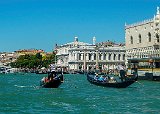
Arrival in Venice.
We arrived in Venice via an early morning Delta Airlines flight to Marco Polo airport. Following the advice found on several web sites we traveled from the airport to the center of Venice (San Marco Square) via the independent Alilunga waterbus. The Red Line boat we were on took over an hour, first going around the outer areas of the lagoon. Stops included Morano and the Lido. This is the scene as the waterbus approached its San Marco stop. The stop was at the end of the trees on the left of the pictures. The entrance to San Marco Square is marked by the two columns in the center of the pictures. The Doge's Palace is the white building on the right. The white structure with gold stripe in front of the palace is the San Zaccaria Venetian public transportation waterbus stop (the vaporetto).
Image 1 of 26
Arrival in Venice.
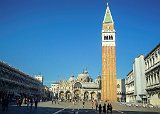
Piazza San Marco (St Mark's Square)
Crowded and noisy, the center of tourism in Venice is St Mark's Square. Since our hotel was just a couple of minutes walk from the square we would pass through it several times a day.
This picture is of the square proper. It was taken in the late afternoon after the bulk of the tourists had left. The view is from the arcade on the western edge of the square looking towards St Mark's Basilica at the far end. The Campanile (the basilica's bell tower) is the tall structure dominating the image. It was built in the 16th century, collapsed in 1902 and was exactly rebuilt, with the internal addition of internal reinforcements and an elevator. Being 323 ft tall there is quite a line for the elevator to the observation level. At the top of the far end of the building on the left is the St Mark's Clock Tower. The bell and the two statues of men that strike it are visible at full magnification.
This picture is of the square proper. It was taken in the late afternoon after the bulk of the tourists had left. The view is from the arcade on the western edge of the square looking towards St Mark's Basilica at the far end. The Campanile (the basilica's bell tower) is the tall structure dominating the image. It was built in the 16th century, collapsed in 1902 and was exactly rebuilt, with the internal addition of internal reinforcements and an elevator. Being 323 ft tall there is quite a line for the elevator to the observation level. At the top of the far end of the building on the left is the St Mark's Clock Tower. The bell and the two statues of men that strike it are visible at full magnification.
Image 2 of 26
Piazza San Marco (St Mark's Square)

St Mark's Basilica at Sunset
The first night in Venice I went out at sunset and walked around the square. At the time I thought that there were a lot of tourists, I was to learn later (and as can be seen in other pictures) there really were not that many. During my walk around I took this picture of the basilica.
Image 3 of 26
St Mark's Basilica at Sunset
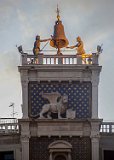
St Mark's Clock Tower at Sunset
Not immediately obvious visually, but very obvious auditorily every hour, is the the St Mark's Clock tower. It dates from the 1490s and was placed where it would be visible from the lagoon to show off the wealth and glory of Venice. The two bronze figures at the top are hinged at the waist which allows them to strike the bell with sledge hammers. They are always known as "the Moors" because of the dark patina acquired by the bronze over the ages. The bell is the original, having been cast in 1497. Below the bell is the winged Lion of Venice. While the Moors and the Bell are original, (as is much of the building, the mechanism has been updated and improved over the years. The last series of repairs were in 1997 and afterwards (the 500th anniversary of the casting of the bell).As I was walking through the square that first night I heard the bell. Looking up, I took this picture.
Image 4 of 26
St Mark's Clock Tower at Sunset
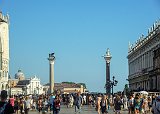
Piazzetta San Marco (St Mark's Little Square)
An extension of St Mark's Square from the basilica past the Doge's Palace to the waterfront on St Mark's Basin is known as the Piazzetta (little Piazza ). A corner of the Doge's Palace can be seen on the left. The building on the right is the National Library of St Mark's. Left of center is the Column of The Lion. It is topped by a winged lion, the symbol of both Venice and St Mark. On the right, in the shade, is the Column of St Teodoro, the patron saint of Venice before St Mark. He is holding a shield and spear, standing on top of a crocodile. The two granite columns are believed to have been erected about 1268, when the water was closer. Then they would have been on the edge of the lagoon, framing the entry to the city from the sea. The church and associated buildings in the background is San Giorgio Maggiore, on the other side of the basin.
Image 5 of 26
Piazzetta San Marco (St Mark's Little Square)
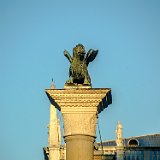
The Lion of Venice
Over the centuries this ancient bronze sculpture toping the eastern column on the St Mark's waterfront has come to symbolize both the city of Venice and its patron Saint Mark. It has been there since the 12th century. Ironically, this statue which is considered traditional symbol of Saint Mark, probably predates Christianity. Its core is believed to have originally been made about 300 B.C. as a winged lion-griffin statue in Southern Turkey . The existing stature is the result of many renovations and additions over the ages, to include the book that the lion is standing on
Image 6 of 26
The Lion of Venice
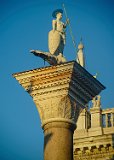
St. Theodore of Amasea
The figure standing on the western column on the St Mark's waterfront is St. Theodore of Amasea. He was the patron saint of the city before St Mark. He holds a shield and spear and he stands on a crocodile which represents a dragon he was said to have slain. The sculpture is made up from parts of antique statues and is a copy, the original being kept in the Doge's Palace.
Image 7 of 26
St. Theodore of Amasea
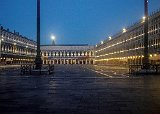
Early Morning in St Marks Square
I was up and out early every morning in Venice. This allowed me to take pictures in the morning light and to see sights without their usual crowds. This picture shows St Marks Square about 5am with the setting full Moon in the background. Previously during the day the square had been wall-to-wall tourists. During the evening the square was slightly less crowded, but the outdoor restaurant seating areas on either side were packed. In the early morning only the pigeons and seagulls were in the square, enjoying the leavings of the proceeding day's tourists and diners.
Image 8 of 26
Early Morning in St Marks Square
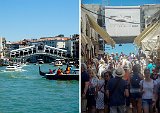
What News On The Rialto?
Being a Shakespeare buff, I had to visit the Rialto Bridge. Completed in 1591 it the oldest bridge over the Grand Canal. Unfortunately, while open, it was being renovated. Thus there no views were available from it. The picture on the left was taken several hundred yards south west of the bridge on the bank of the Grand Canal. The view was far enough away to minimize distractions from the renovation. While, the bridge looks deserted, as the picture on the right shows, it was really quite crowded. In the "olden days" (late 16th century) this area and bridge were the commercial heart of Venice - hence "What news on the Rialto?". Modern Venetians know of the bridge's popularity among tourists resulting in the contiguous row of souvenir stalls on either side of the bridge as well as at the foot on both sides. The sign at the top translates " Restoration Project, Rialto Bridge".
Image 9 of 26
What News On The Rialto?
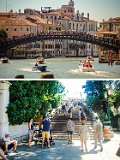
The Academy Bridge
The Academy Bridge was the second crossing of the Grand Canal. Located about 3/4th of a mile from the Rialto Bridge near the canal's southern end, It is named for the Accademia di Belle Arti di Venezia (Academy of Fine Arts of Venice) which was located on the west side of the canal. The original structure was completed in 1854. A replacement occupied the location from 1933 to 1985 when the current bridge was built. This was the bridge we used most often to get to the sites on the other side of the Grand Canal from San Marco. It had the advantage of not having any souvenir stalls to waylay tourists. The upper picture was taken from The Grand Canal Terrace of the Peggy Guggenheim Collection. The lower picture was taken from the eastern side of the bridge.
Image 10 of 26
The Academy Bridge
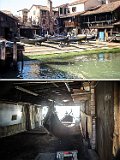
Squero di San Trovaso Gondola Workshop
With several hundred gondolas plying the venetian lagoon and canals, there must be a place where they are built and serviced. In fact there are only a handful of such "sequeri". Most of these are in locations that tourists seldom see, but the oldest and most famous is the Squero di San Trovaso. It is located on the San Trovaso Canal, just off of the Giudecca Canal (the main large boat channel), near the Academy Bridge. While no tours are available, much of the work is in the open with an excellent view from across the canal. Note that while most Venetian buildings are made of stone, the yard consists mostly of Tyrolian-looking wooden structures dating from the original Alpine immigrants who established the yard. The top picture is a view of the yard from across the canal. The bottom pictue is a view through a window of the enclosed shed at the squero taken in a walk around the outside.
Image 11 of 26
Squero di San Trovaso Gondola Workshop
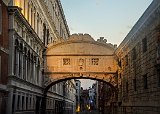
The Bridge of Sighs at Sunrise
The Bridge of Sighs is an enclosed bridge connecting the interrogation rooms of Doge's Palace on the left with the New Prison on the right crossing over the Rio di Palazzo canal. Lord Byron, supposedly gave the bridge its name based on the assumption that prisoners would sigh as they looked through the stone bars of the bridge's windows and saw their final view of beautiful Venice before being taking down to their cells in the dungeon. In fact, based on my observations going through the bridge on a tour of the Doge's Palace, one really cannot see much through the windows. This picture was taken during one of my sunrise excursions.
Image 12 of 26
The Bridge of Sighs at Sunrise
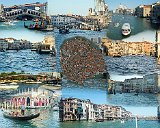
Vapperato Cruise Down The Grand Canal
Several of the travel guides and websites recommended taking a Vapporato cruise down the Grand Canal. In the center of this collage is a map of the Grand Canal with the places I took the pictures marked. Clockwise from the top left is the Rialto Bridge; The Ponte degli Scalzi, (Bridge of the Barefoot Monks) crossing the Canal at the railroad station; the southern end of the canal with a northbound vapperato; a view of the canal at the northern most bend; a view of the Palazzo Giustinian and the Ca' Foscari University of Venice (founded in 1868) - both examples of late Venetian Gothic architecture; the southern end of the Grand Canal taken near the Peggy Guggenheim Collection; a gondola heading down the canal with tourists; The Ponte di Calatrava, the newest bridge over the Canal located at the northern entrance; and a pair of vapperato stops along the canal.
Image 13 of 26
Vapperato Cruise Down The Grand Canal
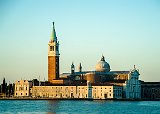
Church of San Giorgio Maggiore
Across the basin from St Mark's Square is the island of San Giorgio Maggiore and the church of the same name. This island and its church drew my attention even before my arrival in Venice. I wanted to get a picture of The Royal Clipper arriving in Venice, and after studying Google Maps and considering the position of the sun, this was clearly the best place from which to take that picture (see the Royal Clipper folder) In addition guide books recommended that rather than spend time standing in line to go up the Campanile of St Marks, one should go to this island and go up its campanile. It would be a lot less crowded, and as a bonus, it would be less expensive. While it is not as tall, the views from it are excellent and there are no crowds urging you to leave. One warning - if you are up there when the bells strike, it will be quite jarring.
Image 14 of 26
Church of San Giorgio Maggiore
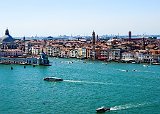
The Southern Terminus of the Grand Canal
This is a view of the Grand Canal's southern terminus. The dome on the left is Santa Maria della Salute (Saint Mary of Health). St Mark's Square is to the right just off the picture. The large boat traveling to the left in the center left of the image is a Venetian water bus, known as a vaporetto. This picture was taken from the top of the San Giorgio Maggiore Church Campanil.
Image 15 of 26
The Southern Terminus of the Grand Canal
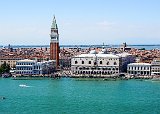
St Mark's Square Environs
A view of the St Mark's Square area. St Mark's Little Square with the columns supporting the Lion of Venice and St. Theodore is just left of center. A number of moored and active gondolas can be seen along the waterfront. The St Mark's Campanile dominates the image. To the right of center is the Doge's Palace in front of the domes of St Mark's Basilica is to the right of center of Italy. Our hotel was less than 100 yards beyond the Basilica. The Italian mainland can be seen in the distance. This picture was taken from the top of the San Giorgio Maggiore Church Campanile.
Image 16 of 26
St Mark's Square Environs
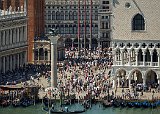
St Mark's Little Square
A close-up view of the St Mark's Little Square with the St Mark's Campanile rising on the left, the column supporting the Lion of Venice left of center. and a corner of Doge's Palace on the left. Taken mid afternoon the crowds in the square can be seen huddling in the shade to avoid the hot sun. Snaking out of the entrance to the Campanile almost down to the waterfront is the line to get in. In fact this line is significantly shorter than it was earlier in the morning. Having waited only one elevator load, I was leisurely taking this picture from the top of the San Giorgio Maggiore Church Campanile.
Image 17 of 26
St Mark's Little Square
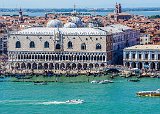
The Doge's Palace
The Doge's Palace with the domes of St Mark's Basilica behind it. The tourist entrance is in the center of the building, below the balcony on the upper floor. The Rio di Palazzo Canal runs to the right of the palace. Looking behind and above the pedestrian bridge the Bridge of Sighs can be seen. Its other end is the "New Prison which is the red roofed building behind the white building on the right. The yellow boat coming into the picture on the right is an Alilaguna Venetian airport waterbus, similar to the one we took. This picture was taken from the top of the San Giorgio Maggiore Church Campanile.
Image 18 of 26
The Doge's Palace
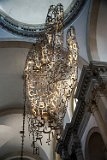
Mercy and Blessing
Displayed within the Church of San Giorgio Maggiore was this large blessing hand by the Spanish artist and sculptor Jaume Plensa. It is formed of 8 alphabets - Arabic, Chinese, Cyrillic, Greek, Aramaic, Hindi, Japanese and Latin. This sculpture display is part of the 2016 Jubilee of Mercy announced by Pope Francis.
Image 19 of 26
Mercy and Blessing
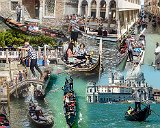
Gondolas, Gondolas Everywhere.
Needless to say, gondolas were ubiquitous. They could be found near all the tourist areas. There were traffic jams along the "popular" ride routes. All gondolas are black by law. In olden times they were so multicolored and garish that black was decreed as a backlash. Most obvious in the pictures are the gondolier outfits. The striped blue shirt was by far the most common, although an occasional red shirt can be seen. Theoretically they should be wearing a red sash, red neckerchief, and a straw hat with red or blue band. While occasional gondoliers might wear them, I saw them mostly on the onshore hustlers trying to drum up business. Also visible in the center is the "ferro", a heavy iron prow which counterbalances the gondolier standing in the back. Not obvious is that the boats are asymmetrical to allow the boat to go straight even though is routinely propelled by a single oar from one side.
Image 20 of 26
Gondolas, Gondolas Everywhere.

Gondola Serenade
Despite their depiction in movies, gondoliers are skilled at maneuvering their boats in the canals, not in singing. In practice a musician and singer duo go along with the boat and serenade the passengers. Frequently a flotilla of 2 or 3 gondolas (and all the pedestrians along the canal) will share a single musical duo.
Image 21 of 26
Gondola Serenade
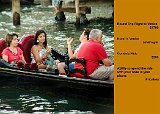
Priceless Gondola Riders in Venice
The city of Venice sets official rates for gondola rides. During the day it will cost €80 ($85)for 40 minutes with additional 20-minute increments for €40. However, according to our hotel, the gondoliers require a very sizeable gratuity commitment in addition to the official fare before they will take you. We did not take a ride and enjoyed watching the gondolas go by. In the process I took this photo of a young lady who was far more interested in her phone than in the ride.
Image 22 of 26
Priceless Gondola Riders in Venice
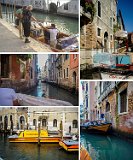
Back Canal Taxi Ride
Our hotel arranged for a tour of a glass factory on Murano. At 9am a guide picked us up at the hotel and walked us to a bridge behind the Doge's Palace where he helped us into a water taxi. We proceeded from there down the back canals out to the lagoon north of the main city. I am not sure how the he avoided hitting other boats or the sides of the canals, but he did. Counterclockwise from the top left: 1) Lucinda getting in the water taxi, (2) a view down one of the canals, (3) All services, includes emergency medical services, must be provided by boats, (4,5) and before most tourists are up and about, service boats were delivering goods to loading docks facing the canal.
Image 23 of 26
Back Canal Taxi Ride

B.F. Signoretti Glass Factory Workshop
Arriving at B.F. Signoretti we were ushered into a glass workshop and watched the making of a two toned horse. I have attended many other glass blowing demonstrations but this one was unique in that they had four furnaces loaded with glass - one clear and three colored. Also in addition to the blowing demonstration, another glass smith took a red gather of glass surrounded by clear glass and proceeded to make a two tone glass horse by pulling on the glass with tongs and using the pipe to help with the shaping. While this horse looks finished, it needed to be annealed. We did buy one that had been made previously
Image 24 of 26
B.F. Signoretti Glass Factory Workshop
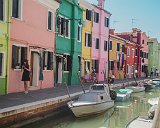
The Colored Houses of Burano
Burano is noted for its multi colored houses. This is a view along one of the canals. The house colors follow a color pattern, dating to the island’s initial development. A homeowners wishing to paint their houses must obtain a permitted list of colors from the government. In a sad commentary on modern times, note the young tourists in the left concentrating on her phone.
Image 25 of 26
The Colored Houses of Burano
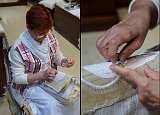
Burano Traditional Lace Maker
Burano's second item of note are its lace makers. The art of Burano lace has been handed down for generations, from mother to daughter dating back at least as far as 1500. The 1600s were the "Century of Lace with extensive lace production facilities. With the end of the Republic of Venice in 1797 "industrial" lace production ceased and it went back to being a family business again. Today it is supported by the tourist trade. A lace shop we stopped in had this lady demonstrating the art. She is using a single, very fine thread to produce the lace.
Image 26 of 26
Burano Traditional Lace Maker

